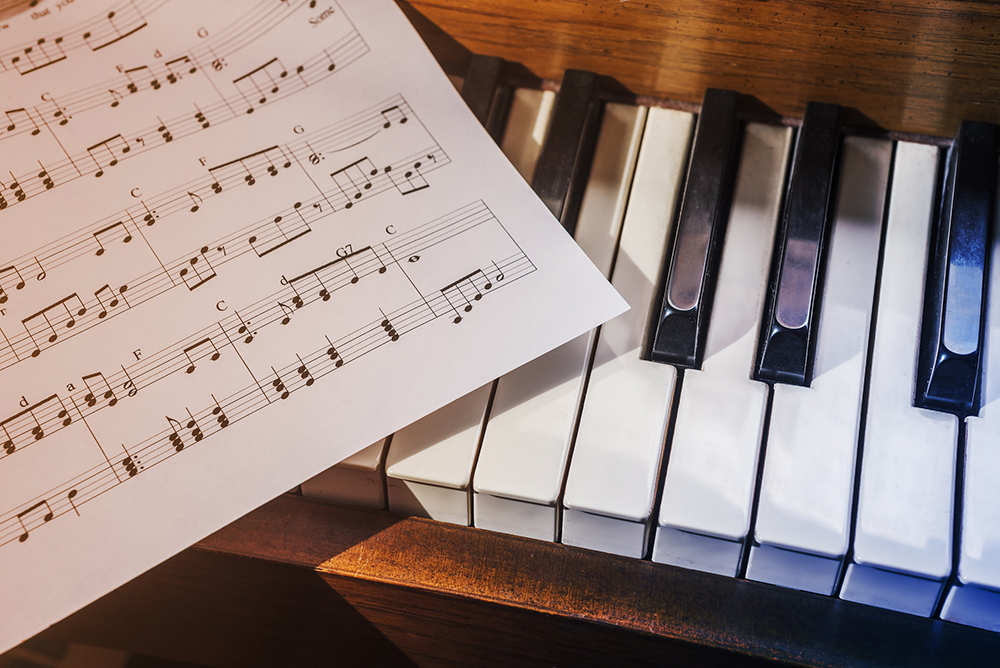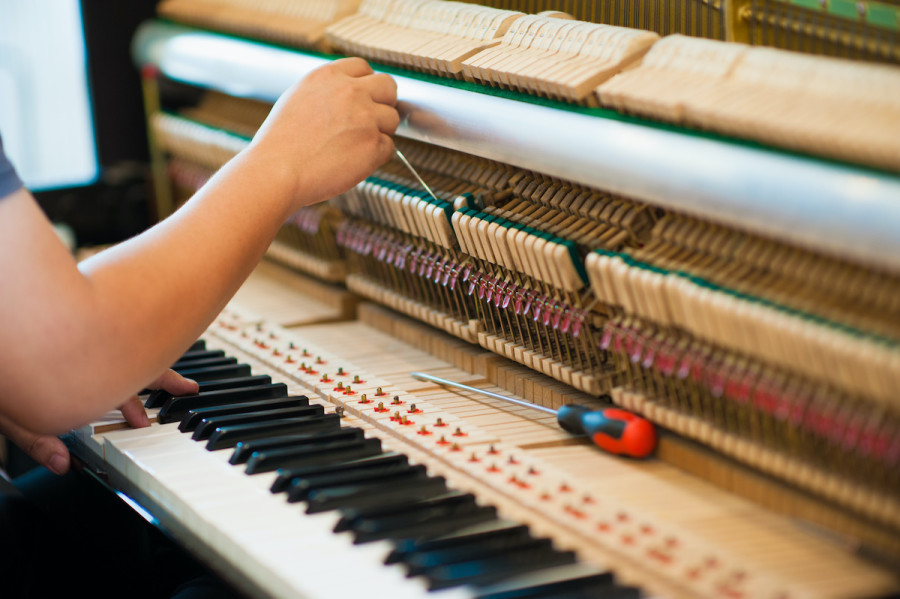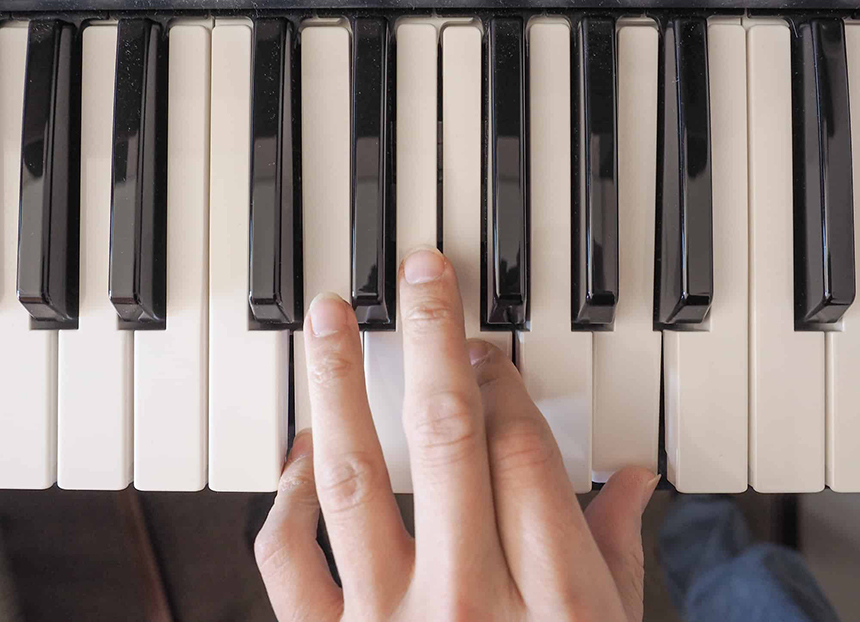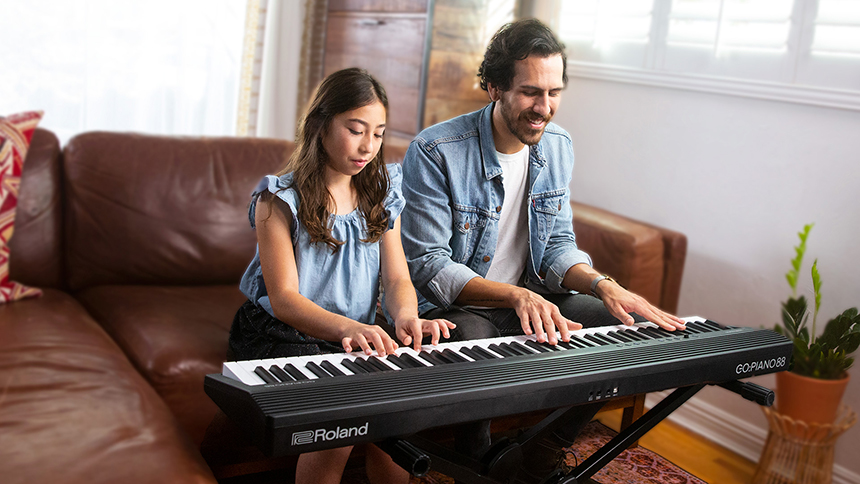
A lot of people dream of mastering the art of playing a musical instrument. If your goal is learning to play the piano, now is a good time to start! But, where do you begin? If you don’t already own a keyboard, how do you go about finding one? Will it be a Baby Grand, the upright honky-tonk piano, or a digital keyboard? You also need to figure out the best ways to learn piano. Mastering the keyboard takes practice and working with a teacher you’re comfortable with. Or, you may decide to learn piano on your own, taking advantage of tutorials on the Internet to guide you. Whatever learning pathway you choose, make sure it’s enjoyable while building up your skills as a piano player. Let’s find all the answers to these pertinent questions so you can get started NOW learning to play the piano!
The first lines from a famous song sung by Julie Andrews give good advice as to how to start playing the piano!
“Let’s start at the very beginning. A very good place to start….”
– Oscar II Hammerstein/Richard Rogers
Starting at the very beginning when learning piano means finding the right instrument. What are your options? Read on to find out!
There are a number of options available to you besides using the conventional acoustic piano as your instrument. Some aspiring musicians prefer to go with a digital keyboard piano, especially as this instrument is portable and doesn’t require to be kept in tune, a necessity with acoustic pianos. Whether you decide on a piano or keyboard, your next step is deciding to rent an instrument or buy one outright. Hiring a musical instrument from your local music store is a good option if you’re still deciding if learning piano is really something you want to pursue. Renting also gives you time to decide whether you prefer the acoustic piano or the keyboard as your musical instrument. Asking family and friends to find out if anyone has a piano sitting unused in their home is a good place to start. You can enquire if they’ll let you practice on it or even let you buy it off them for a reasonable price. If the keyboard is your pick, finding the best digital piano for beginners is a good place to start if you’re limited in space and want to learn quickly.

Familiarizing yourself with the instrument is key to understanding how your piano or keyboard operates and sounds. Every musical instrument has its own quirks, and getting to know them makes you more comfortable when you start practicing with it! It also helps you to know if your acoustic piano needs to be tuned or not. Ideally, this should be done once a year Trusted Source Care and Maintenance of a Piano:Tuning Once a Year - Musical Instrument Guide - Yamaha Corporation Piano strings are strung under tremendous tension, averaging 90 kilograms each. Hence, even if the piano is not played, the strings will gradually stretch with the passage of time and the piano will fall out of tune. www.yamaha.com .
Some tips for getting to know your acoustic piano or digital keyboard include:
Now that you’ve found your instrument and you know all its ins and outs, the time has come to choose your learning path. Will you work with an experienced music teacher, or do you want to be guided by online teaching programs? Knowing your learning style Trusted Source Learning Styles | Center for Teaching | Vanderbilt University The term learning styles is widely used to describe how learners gather, sift through, interpret, organize, come to conclusions about, and “store” information for further use. As spelled out in VARK (one of the most popular learning styles inventories), these styles are often categorized by sensory approaches: visual, aural, verbal [reading/writing], and kinesthetic. Many of the models that don’t resemble the VARK’s sensory focus are reminiscent of Felder and Silverman’s Index of Learning Styles, with a continuum of descriptors for how learners process and organize information: active-reflective, sensing-intuitive, verbal-visual, and sequential-global. cft.vanderbilt.edu is essential for you to enjoy the experience when mastering your piano or keyboard skills.
If you appreciate and learn better by being guided by someone else, finding the right piano teacher is key to your learning journey. The next question to ask yourself is whether you want an in-person piano teacher (yes, they do still exist!) or if you want to work with an expert online.
Asking your local music store is a good place to start when looking for an in-person piano teacher. You can also search online or check out local community boards for teachers advertising for students.
Online teachers can be easily sourced by browsing online. Taking this option broadens your reach, and you can access an online piano teacher from anywhere in the world! Asking for recommendations from other students or a music store gives you peace of mind you’re working with a professional when selecting an online teacher. Check out online reviews, too, when deciding to use a teacher through Zoom or Skype.
If your learning style leans more towards “doing it yourself,” there are a number of ways you can use this method successfully, thanks to digital technology! There are troves of musical programs and online courses designed to help beginners, such as you learn piano. These resources allow you to work at your pace whenever you have time to practice. They take you through the process step-by-step, ensuring you master playing the piano naturally and in a fun way. Online programs are often the best solution for people leading busy lives.
A well-designed program will give you the solid foundation you need to go beyond playing only a few songs. You’ll develop skills from the basics to advanced, equipping you to go as far as you want to go when learning piano. Some beginner digital pianos come with their own online app for teaching you to play the instrument. Dedicated software and apps for digital pianos are another way of learning a keyboard on your own. While they use features such as online videos, these programs mostly teach you the basics of using a keyboard without giving you comprehensive musical theory. But you’ll be equipped with the skills to play some of the most popular songs and tunes. This type of software or app can be plugged into other devices such as your tablet or mobile, syncing with your musical instrument. Constructive feedback can be given, highlighting aspects such as playing the wrong note. It would be advantageous to own a pair of headphones for digital pianos so you can benefit fully from the software and apps. This method is an exceptionally easy way of learning piano. But your musical knowledge and skill won’t be advanced enough to allow you to strut your stuff beyond the tunes learned using the digital platform.
You’ve got the instrument, you’re familiar with it, and you’ve chosen your learning pathway. Now, it’s time to get down to the nitty-gritty of studying the basics of piano playing! While strumming “Do-Reh-Mi” may seem easy, hitting the right chords to the tune of “Bohemian Rhapsody” is another story altogether! But it’s possible when you start at the beginning and study the notes, scales, and chords that are fundamental to becoming an expert musician. Getting to know and understand notes, sharps, and flats is the first step to studying the core basics of piano playing.

On the piano, there are multiple octaves consisting of sets of notes labeled A to G. When learning the word alphabet, you know you always start at A. The musical alphabet is a little more confusing, with it starting at C since you’ll usually navigate from the middle C. To your right are octaves that become higher in pitch, while to the left are octaves that produce lower notes. Piano music on a page will use these letters or a visual representation to tell you what to play. In the visual representation, musical notes are shown on a music staff, and each position is a different note you need to play. The following is important when learning the notes:
Studying the basics of piano playing also means getting to grips with sharps and flats. Every piano or keyboard is made up of black and white keys. What do they represent? When placing the musical alphabet on the keyboard, as mentioned above, you would have started with the white keys.
The black notes are the sharps and flats, which are a semitone higher or lower than the white notes next to them. On sheet music, sharps are represented by the symbol “#” while flats are recognized as “b” next to the note.
Scheduling practice time into your daily routine ensures you sit down and do the exercises. Committing to this means you can achieve your dream of playing a musical instrument fluently when at one stage, you thought it was impossible! Learning piano with a private in-person or online teacher makes it easier to commit to a schedule. If you’re taking the “do-it-on-my-own” route, you’ll need to be strict with yourself when implementing and sticking to your learning schedule. Identifying the best time of the day for practicing the piano or keyboard requires knowing your own strengths and weaknesses! Are you a late-night owl who prefers to spend time doing piano exercises while everyone else is sleeping? Or, are you more productive first thing in the morning? Knowing when your best time is for focusing on piano practice will help you feel motivated to stick to your schedule. Other ways of sticking to your schedule include:
Reminding yourself why you started learning piano in the first place is also good motivation for sticking to your schedule.
Practicing the foundational basics of playing the piano or keyboard over and over again will give you the building blocks you need when you start learning your favorite songs. But, how much should you practice? Teachers and experienced musicians will tell you that anything between 10 to 15 hours every week is a good goal. Professional piano players will practice up to four hours a day! If this seems daunting to you, start slowly and build up. Breaking your practice sessions into regular 15 to 30 minutes sessions is more do-able than trying to slog it out, cramming hours in every day. This way, you can enjoy learning the piano while still finding the time to practice.
When learning a new musical instrument, there are always tricks of the trade worth taking note of! While these tips won’t speed up the process of learning piano, they’ll help you to reach your goal of mastering the keyboard.

It’s tempting to try and conquer the art of playing the keyboard all in one sitting by rushing the process! But, it’s not possible. This approach will simply overwhelm you and cause you to quit before you’ve learned how to play your first tune. Going slow and steady means studying and understanding the basics while giving your fingers a chance to familiarise themselves with the positioning of the keys. Keeping it slow means pacing out your practice sessions and avoiding lengthy, drawn-out times at the piano, which could wear you down.
Taking care of your fingers and hands is crucial if you want to prevent injury when playing the piano. And, yes, this can happen if you hit the keyboard before doing some fingers and hands stretching exercises to warm them up. We tend to take this part of our body for granted, expecting it to do any work immediately on our command! But hand and finger exercises allow these appendages to be more flexible and relaxed when flying over the keys while preventing stiffness and injuries. Hand exercises Trusted Source Why Hand Exercises Are Important - Fitzmaurice Hand Institute You need your hands more than any other part of your body to complete your daily tasks. At the Fitzmaurice Hand Institute, we are committed to providing treatments that are optimally effective at providing relief and restoring hand function. Our hand experts constantly strive to expand the precision of hand surgery through minimally-invasive techniques that will help you get back to your life more quickly with outstanding results. fitzhand.com are vital for:
There are many online videos demonstrating how to do hand and finger warm-ups before playing the piano. Make sure you do them if you want to protect your most essential appendages for learning piano!

Playing with others keeps you motivated and helps you stick to your schedule. Also, spending time with those who know more than you do expedites your learning process. This is especially valuable if you’re teaching yourself to play the keyboard or acoustic piano. Finding an experienced acoustic or digital piano player who is willing to play with you is akin to finding a gold nugget! They’ll point out areas of improvement to you, but they’ll also share tricks of the trade to improve your instrumental skills. If you can’t find a mentor, speak to someone at the local music store. They may know of skilled keyboard players who are willing to spend some time playing with you. Otherwise, ask your friends or family to lend an ear while you’re playing.
Learning to sight-read music is a skill all of its own. It’s also one of the most valuable tools for learning piano. But, it’s one of the most challenging and time-consuming aspects beginners can struggle with. It entails recognizing notes on lines and spaces drawn on the music sheet. However, persevering means you get to play any tune or song you want to as you progress. Sight-reading music also means you can learn to play other musical instruments if you want to switch over from the piano or keyboard. Learning to sight-read takes dedication and commitment. But, if you’re serious about playing piano and taking it beyond strumming out simple melodies, then learning to read piano sheet music is essential.
Learning piano doesn’t happen overnight! It helps to set realistic goals, so you don’t feel disappointed when you’re still only playing “Do-Reh-Mi” at the end of your first month of tackling the keyboard. Mastering any musical instrument takes time and perseverance. By setting down milestones, you can gauge your progress while celebrating every step of achievement. When setting realistic goals, take note of the following:
Having your goal printed out next to your piano or keyboard will remind you, every time you sit down, why you’re learning this instrument. Keeping it really means you are committed to the long and slow process of developing a new and wonderful skill.
Learning to play a musical instrument such as the piano is one of the most rewarding experiences you could add to your life. While progress may seem to take forever, you’ll be thrilled the day you get to play your favorite song on the piano! If the instrument of your dreams is one of the best digital pianos on the market, you’ll learn even faster. Whatever your choice of instrument and your learning pathway, using our tips for the best ways to learn the piano will give you the head start you need as a beginner. Always start at the very beginning. And, remember, practice does make perfect, so keep on keeping on and stick to your schedule. You’ll be glad you did when you become a master piano player!